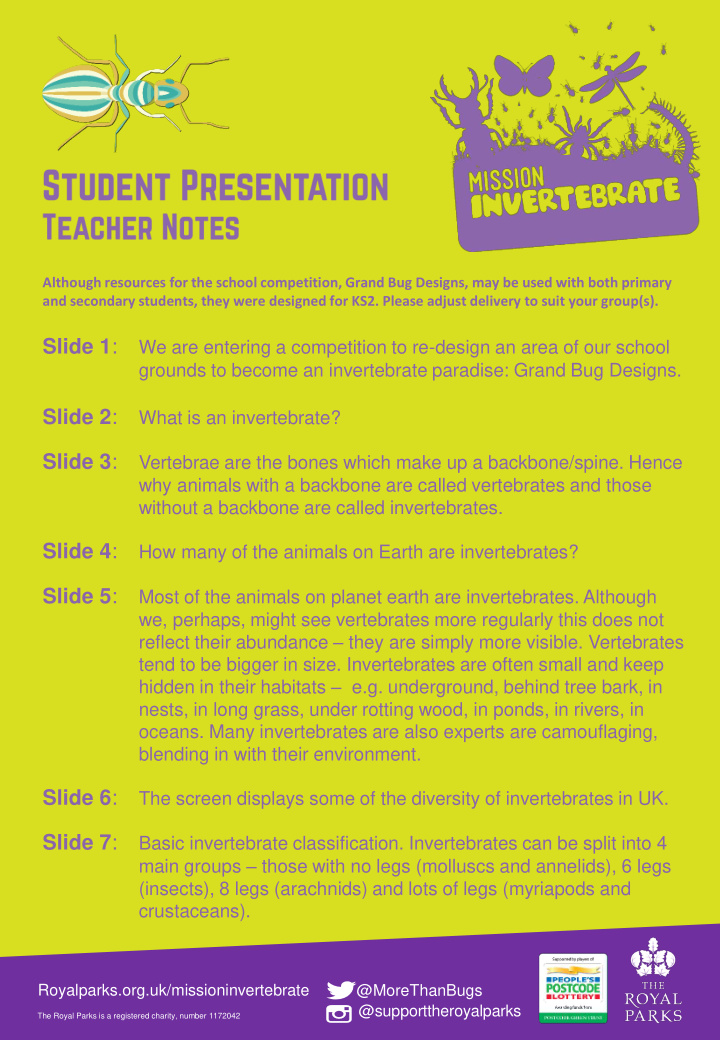



Although resources for the school competition, Grand Bug Designs, may be used with both primary and secondary students, they were designed for KS2. Please adjust delivery to suit your group(s). Slide 1 : We are entering a competition to re-design an area of our school grounds to become an invertebrate paradise: Grand Bug Designs. Slide 2 : What is an invertebrate? Slide 3 : Vertebrae are the bones which make up a backbone/spine. Hence why animals with a backbone are called vertebrates and those without a backbone are called invertebrates. Slide 4 : How many of the animals on Earth are invertebrates? Slide 5 : Most of the animals on planet earth are invertebrates. Although we, perhaps, might see vertebrates more regularly this does not reflect their abundance – they are simply more visible. Vertebrates tend to be bigger in size. Invertebrates are often small and keep hidden in their habitats – e.g. underground, behind tree bark, in nests, in long grass, under rotting wood, in ponds, in rivers, in oceans. Many invertebrates are also experts are camouflaging, blending in with their environment. Slide 6 : The screen displays some of the diversity of invertebrates in UK. Slide 7 : Basic invertebrate classification. Invertebrates can be split into 4 main groups – those with no legs (molluscs and annelids), 6 legs (insects), 8 legs (arachnids) and lots of legs (myriapods and crustaceans). Royalparks.org.uk/missioninvertebrate @MoreThanBugs @supporttheroyalparks The Royal Parks is a registered charity, number 1172042
We wouldn’t be able to survive without invertebrates. They: Slide 8 : POLLINATE (pictured: bumble bee; peacock butterfly; hoverfly; soldier beetle) • Pollination is the transfer of pollen from one flower to another flower of the same species. This results in fertilisation and seeds are made. • Many invertebrates do this inadvertently when feeding on nectar and pollen at flowers. Bees, butterflies, moths, flies (especially hoverflies) and beetles are common pollinators. • Invertebrates pollinate many of the crops we eat. We wouldn’t have apples, pears, coffee or chocolate without invertebrate pollinators. RECYCLE (pictured: pill woodlouse; springtail; slug; millipede) • Detritivores help break down particles and recycle nutrients in rotting plant and animal material, by eating it. • Common detritivores are woodlice, springtails, slugs, millipedes and earthworms. They are found in any environment with dead organic matter. • Without them, dead organic matter would pile up and the world would not be a very pleasant place to live in. FOOD SOURCES (pictured: harvestman; snail; ant; cricket) • A food chain is the order of transfer of food energy from one organism to another in an ecosystem. Energy flows up a food chain from lower to higher trophic levels. Within an ecosystem there will be many food chains that overlap and interconnect, forming a complex food web. • Invertebrates are a critical part of food webs, representing a source of food for many animals. • The complexity of food webs means that they can be very fragile and need to be maintained in order to stay balanced. Without invertebrates in food webs, they’d fall apart. Royalparks.org.uk/missioninvertebrate @MoreThanBugs @supporttheroyalparks The Royal Parks is a registered charity, number 1172042
Slide 9: Invertebrates play these vital ecosystem roles, yet we are losing them. Which invertebrate threats are represented by the graphics on screen? Answers: Habitat loss – Pollution – Over-hunting – Invasive species – Live capture. Slide 10: We know that invertebrates are incredibly important and in are decline (they are faced by a number of threats) so our mission is to find out more… Mission: Invertebrate is a project that challenges us to understand the invertebrates that call the Royal Parks their home. We are surveying the Royal Parks in London to find out which invertebrates live there already, and how many. This is called surveying. It helps us know how to help the ones already living there. We also try to attract new invertebrates. Slide 11: We know that invertebrates are incredibly important and in are decline (they are faced by a number of threats) so another of our missions is to do more… Mission: Invertebrate create natural habitats in the Royal Parks to help the invertebrates already living there, AND to attract new ones. Slide 12: Teacher introduces competition and how you as a class, or school, will approach it. Royalparks.org.uk/missioninvertebrate @MoreThanBugs @supporttheroyalparks The Royal Parks is a registered charity, number 1172042
Recommend
More recommend